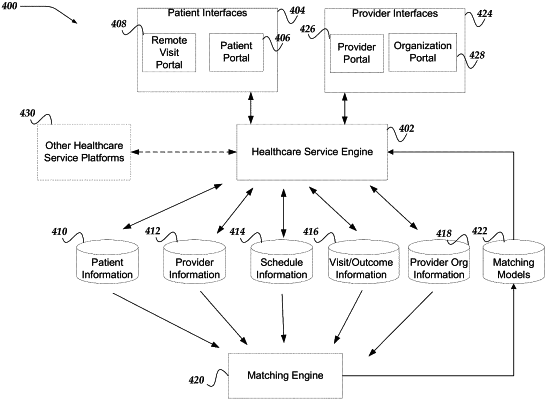| CPC G16H 80/00 (2018.01) [G16H 40/20 (2018.01)] | 30 Claims |

|
1. A method for managing provisioning of healthcare services over a network, wherein the method is configured to cause one or more network computers that include one or more processors to perform actions, comprising:
generating one or more user interfaces for a patient to provide a visit profile and request a visit to obtain healthcare services from a provider organization, wherein the visit profile includes geo-location information for the patient and one or more of a reason for the visit, symptom of an illness, sociographic information, or patient information, and wherein the provider organization employs the visit profile to select one or more of an interface control or local information that is included in the one or more user interfaces generated for the patient;
generating a booking flow representing intermediate progress of the patient for a current process that includes a plurality of portions in booking the visit, wherein the booking flow is used by one or more health care service engines to continuously and simultaneously provide for starting and stopping progress in the plurality of portions for booking the same visit by the patient from a plurality of types of applications that provide remote access to one or more portions of the one or more user interfaces generated to guide the patient through the booking flow based on conforming to one or more of a health care setting or a modality that aligns with both the patient's interests and one or more policies of the provider organization, and wherein the plurality of application types include one or more of a mobile application, a desktop application or an online application;
dynamically generating one or more selected user interfaces for the patient during the intermediate progress based on information collected during one or more of the plurality of portions for the current process to complete booking the visit;
determining one or more providers that are associated with the provider organization and are locally available to provide the requested healthcare services and virtually available to provide the requested healthcare services;
generating one or more matching models based on a localized requirement for the requested healthcare services, an objective of the provider organization, one or more metrics for outcome histories associated with the one or more providers, and heuristic data for the requested healthcare services;
generating one or more match scores for the one or more providers based on the one or more matching models and the visit profile, wherein each match score represents a quality of a match for assigning the one or more providers to the visit requested by the patient;
assigning a provider that is locally available for the visit and assigning an alternate provider that is virtually available for the visit based on the one or more match scores;
providing a virtual waiting room for the patient based on the visit profile, wherein one or more user interfaces in the virtual waiting room enable one or more interactions between the patient and the virtual waiting room, and wherein the virtual waiting room includes an estimated travel time, a cost, and a wait time to meet in person with the locally available provider and further includes an alternate cost, and an alternate wait time to communicate with the virtually available alternate provider;
updating the visit profile with supplemental information based on one or more of an interaction between the patient and the virtual waiting room, patient information from one or more data stores, or visit information from the one or more data stores;
providing one or more updated match scores for the one or more providers based on the one or more matching models and the updated visit profile; and
in response to an updated match score exceeding a previously determined higher match score, assigning one or more of another provider or another alternate provider to the visit based on the other provider or the other alternate provider being associated with the updated match score, wherein the visit is conducted by the other provider or the other alternate provider.
|